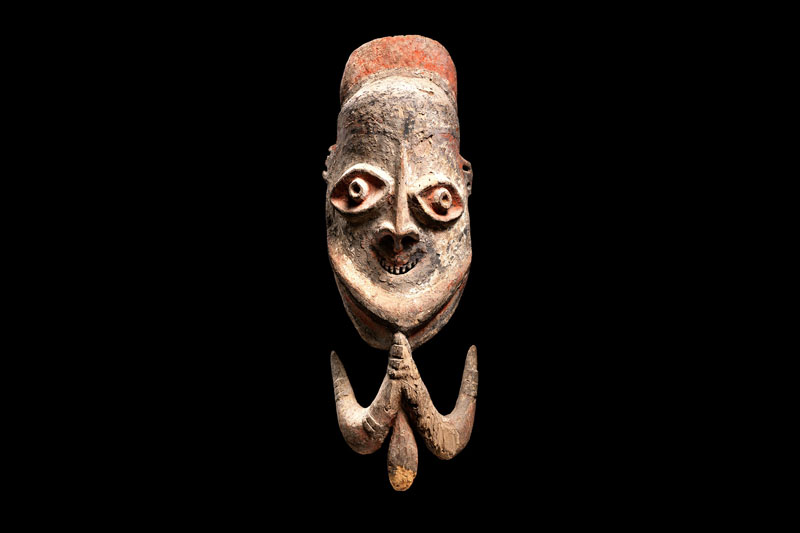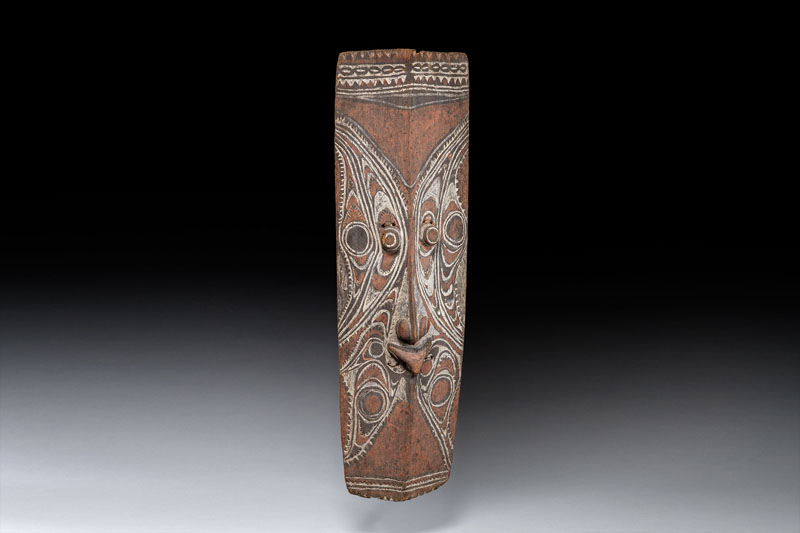Lecture by Michael Hamson, Savage Club, Melbourne, 21 October 2017
This article continues on from Part One which appeared in the last edition of the OAS Journal where Mr. Hamson looked at the criteria of Age; Technical Virtuosity, and Clarity in assessing New Guinea art.
- Colour
It is hard to over-emphasize the importance of colour in New Guinea art. For the local people colour is often the most ritually significant element to an object. It is literally the magic that empowers a piece. Without colour on a carving the artifact is just a piece of wood. With the animating power of paint, the piece becomes an ancestor with all his/her supernatural powers.
These small gourd masks from the Eastern Highlands were said to represent the spirits that caused leprosy and were used to taunt young men into better behaviour. The nose and eyebrows are made from wax and there is human hair attached on the eyebrows and chins. This example is one of the best in the world because of the striking yellow pigments and the powerful red line that dissects the face and pools down at the chin.
In my opinion the abstract but perfect application of colour on this shield is magnificent. The colours are saturated and layered with a richness that perfectly compliments the rough-hewn adze marks and dark aged patina below the surface. The painted designs on shields often had dual functions—both to stun and confound the enemy viewing it from the front and also to protect and empower the warrior holding it from behind.
The colour red is often used throughout New Guinea and frequently is said to manifest “heat” or power. It is thought to be the empowering ingredient on ceremonial objects and is often ritually applied. Thus I am often looking for layers of pigments which in effect represent the ritual history of the object. The crackling layers of red uncovering previous layers of red pigment give an object an intensity and significance.
- Departures from the Norm
Another characteristic of great New Guinea art is its ability to provide the unexpected. A true artist comfortable and confident with the existing canon will try to expand or deviate from the artistic tradition. While we viewers of art often find pleasure in symmetry and the careful execution in form what often what really excites us is encountering something slightly different. There is an aesthetic experience in having our expectations cleverly twisted and re-presented. The sometimes small deviations from the norm often expose the hand of a great artist.
This ancient pre-contact, stone carved ancestral figure from the Lower Sepik River area has a heavy distended belly, huge feet and small stunted arms — the effect is pleasingly different, charming and unexpected — consciously different than all the other pre-contact Lower Sepik figures.
This departure from the norm that I am referring to does not have to be blatant or obvious. It could be, as with this Mendi shield (top right), subtle and refined. The traditional medial ridge that bisects these shields here splits into two raised arches that beautifully alter and highlight the two triangle motifs normally encountered on that section of the shield.
- The Affecting Presence
The affecting presence in the best New Guinea art is the sense that the original spirit manifested in that piece still lurks within it. It is a presence that can be terrifying and menacing or intentionally subdued and restrained. But it is always powerful. It is the quality that looks back at you, that tells you that there is something beyond the wood, the cane and the paint. It is the presence that made the piece effective in its original context and it is the presence that continues to draw us today. It is the feeling that we are in the presence of something beyond normal, something once and always alive, something extraordinary.
For pieces to be effective one must get the sense that they work, that the spirit is not just represent on the object but is in fact manifested by that very carving. As humans we make our connections through eye-contact.
When evaluating a piece of New Guinea art the first thing I do is hold it up and see if it makes a connection. Was the artist able to convey the living presence behind the piece. That living, breathing still powerful presence is clearly visible in this pre-contact face from the Yangoru Boiken area (above)
You look at 99% of New Guinea art out there and yes, you see the figure, you see the face but does that piece draw you into it. Does it engage your soul? Does it convince you that it was once and probably still is alive? It is impossible to escape the gaze of this pre-contact Yangoru Boiken ancestral figure (below).
This power of presence is located in the gaze and this wood Abelam bapahelmet mask (above) is all about the gaze. Much of Abelam art, especially the painted façade of the tall ceremonial haus tambaran, focus on the eye motif to stun and awe the viewer. Here in this mask the bulging concentric eye motif is both startling and mesmerizing.
- Aesthetics of Integrity
In 2007 I wrote my second catalogue entitled “The Aesthetics of Integrity” and tried to define a characteristic of great New Guinea art that over the years I had begun to appreciate. In that catalogue I wrote that:
In reference to people, the term integrity refers to honesty and strength of character. It connotes forthrightness and being true to one’s self. In the art of New Guinea certain pieces possess similar traits, where everything about the object, down to the smallest details of form, expression and surface are completely true to an object’s function. This quality is often encountered in pre-contact pieces where objects are often free from any hint of decadence or any whiff of ulterior motive. In the hands of a gifted artist the sculptural form initially created will manifest this purity of intent. The aesthetic of integrity continues after the original work is composed and can be seen from the patina, the layers of pigment and the proper wear after generations of field use. That the object has spent extensive time in the field serving the needs of the people who made it suggests a cultural soundness and compatibility; it has been deemed worthy and appropriate by the culture that produced it.
When a work of art has integrity everything about it seems right and correct, from the heft of it in hand to the smoothed surface where it was gripped. It is all those tangible elements showing that every line, curve, and volume fit the original composition while all the wear, patina, piercings, attachments and pigments confirms its long traditional use. Integrity can also be found in all the intangible qualities such as expression, character and the sense of magical or spiritual weight; where the original animating presence is still vital; where the ancestral fire within still burns bright. When a work of New Guinea art has integrity it does more than confirm our expectations, it redefines them. The honesty of the piece tells us more about the art, the culture and the people than we knew before.
This wonderfully ancient Lower Sepik River mask (bottom left) has a bulging forehead, deep-set oval eyes, a broad flanged nose pierced through the septum and the nostrils. The mouth is open as in process of breathing. The holes around the perimeter are numerous and reflect frequent attachment to various dance costumes. The patina is dark, brown and glossy. There are hints of remaining colour.
In the above image the integrity lies in the thick aged dark brown patina perfectly in sync with the early classic style of Huon Gulf bowl with its raised and pierced nose, high relief eyebrows and open mouth display a full set of aggressive and sharp teeth—the latter a nearly universal sign of an early New Guinea figurative object.
Looking at this beautiful old Sepik shield (right) one would think it would be obvious to spot its quality. Yet when I first encountered this shield it was in a low-end general antique and collectable auction placed amongst a group of typical Sepik tourist carvings. As my eye quickly scanned the group and dismissed them it stopped and lingered on this shield. Thank God it did. Then once I took the time to register the details—the refined painting, the raised eyes, nose and mouth with distended tongue. The design details carved not just painted and the graceful angular fold of the front of the shield itself. The surface had a softness that many of the oldest Sepik artifacts exhibit. I of course flew to Chicago to see the shield and bid in person. Upon further research the shield was found to be collected in 1912/13 on the Kaiser Augustus Fluss exhibition, illustrated in a 1929 article on Sepik shields, acquired by the renowned Raymond Wielgus and exhibited at the Museum of Primitive Art in 1960 and now resides prominently displayed at the Quai Branly Museum in Paris. I credit the inherent integrity of the shield more than anything else that caused my eye to stop and further investigate its beauty.

Caption: Eastern Highlands gourd mask. Image courtesy Michael Hamson.

Caption: Mendi shield. Image courtesy Michael Hamson.

Caption: Red Lower Sepik/Ramu mask. Image courtesy Michael Hamson.

Caption: Eastern Highlands neckrest. Image courtesy Michael Hamson.

Caption: Lower Sepik Figure. Image courtesy Michael Hamson.

Caption: Mendi Shield with two arches and red paint. Image courtesy Michael Hamson.

Caption: Yangoru head from figure carving with yellow paint. Image courtesy Michael Hamson.

Caption: Boiken pre-contact hook with face. Image courtesy Michael Hamson.

Caption: Wooden bapamask. Image courtesy Michael Hamson.

Caption: Lower Sepik mask. Image courtesy Michael Hamson.

Caption: Huon Gulf bowl. Image courtesy Michael Hamson.

Caption: Wielgus Sepik shield. Image courtesy Michael Hamson.

